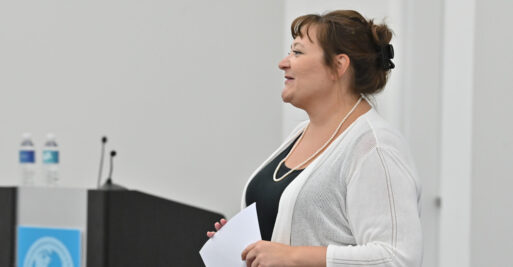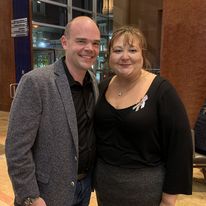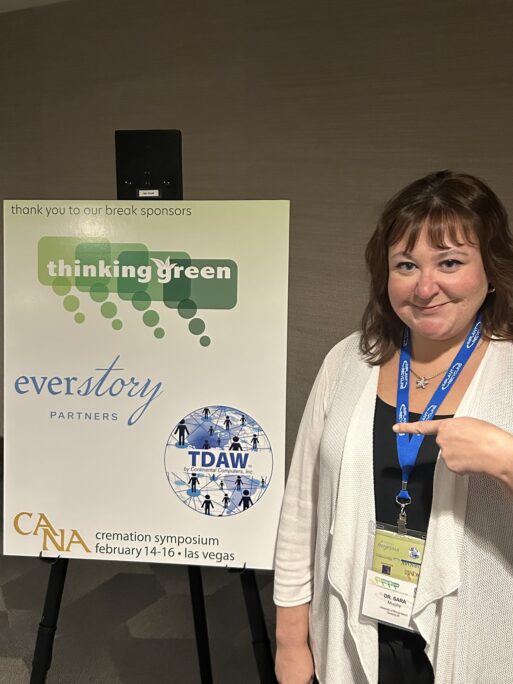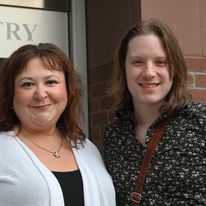
Sara Murphy speaks at the 2023 NFDA Convention on Recognizing and Responding to Suicide Risk in the Deathcare Professions.
After 18 years as a suicidologist, Sara Murphy, Ph.D., FT, is pleased to note that contemporary culture is beginning to shift – albeit slowly – to reflect a better understanding of the causes and effects of suicide. Murphy, a certified thanatologist and death educator, is certainly doing her part: she has taught more than 60 courses on thanatological theory, death, dying, bereavement and related subjects at the University of Rhode Island. Murphy also teaches as affiliate faculty in the Thanatology Graduate Program at Marian University, leads professional development and educational workshops and seminars, and serves as an expert witness on suicide and disenfranchised grief.
Editor’s note: This interview has been edited for length and clarity.
Why is there so much stigma around suicide?
I believe that suicide remains one of the most misunderstood and stigmatized causes of death in our contemporary culture. The stigma itself is very complex. There are historical roots – if we look at American culture, suicide was quite literally criminalized for centuries. People who attempted suicide could lose their land and their assets. There are religious roots as well. In the U.S., which has been historically dominated by Protestant Christianity, suicide is seen to have Biblical origins as the only unforgivable sin.
Then, we look to cultural institutions like education and healthcare and media, and none of them have adequately broken open the realities of suicide to the degree that we can start dismantling the negative association we have, not only for people who die of suicide, but for people who are living with active suicidality. There is an immediate negative connotation toward their character or actions, or toward what they have done for themselves or what we perceive they have not done for themselves. And while I think that stigma has lessened to some degree in the last couple of decades, it’s still so deeply ingrained and rooted that it makes people who are living with suicidality, suicide attempt survivors, and those who are bereaved due to suicide still feel the weight of that stigma.

Murphy with Tim McLoone, LFD, with whom she co-founded Deathcare Proud: LGBTQ+ Deathcare Professionals & Allies
How does that stigmatization or the silencing of suicide affect survivors of suicide loss and their communities?
Stigmatizing suicide, and also not being able to have productive, evidence-based conversations about suicide, means that people who are grieving a suicide death loss are much more likely to do so in isolation and without the kind of support that they would be afforded from a community if their loved one died of cancer or a heart attack. They may be more likely to reach out to professionals for mental health support after a suicide death loss. And that stigma and silencing also fails to acknowledge the pain of the person who died, because of the way in which we reinforce myths about suicide. So this can divide communities; it can divide families, and it can also lead to a higher risk of negative physical and mental health outcomes for those survivors. So on a macro level, responding to what I call our public health crisis of suicide with silence and stigma is ignoring that suicide is an epidemic within our culture, and that it isn’t being adequately addressed. That also limits our ability to more effectively adopt suicide prevention measures.

Murphy poses at CANA’s 2023 Cremation Symposium
What are some of the common myths around suicide?
I could talk for hours on myths alone. These are all perpetuated by a lack of education, peer-to-peer learning that is not based in science or in real experience, and barriers to effective communication. For me, the top five myths are:
Myth #1: That suicide is the result of depression. Statistically, we know that most people who live with depression never become suicidal. We also know that depression is not even the mental health disorder that loses the highest percentage of its cohort to suicide. It’s actually anorexia – 20% of people with anorexia die of suicide. Ten percent of people with borderline personality disorder die of suicide. The number for people living with depression is actually much smaller, but we’ve collapsed these ideas. So that disenfranchises all the people living with suicidality who don’t have depression and think, “Well, I can’t be suicidal, I don’t have depression.” And then it disenfranchises the millions of people living with depression who are terrified that they’re going to become suicidal, and don’t need to be. People try to create easy narratives about why people died of suicide, which can be problematic.
Myth #2: That suicide is a quick fix, or an easy way out. That minimizes the severity and longevity of suicidality for most people. Most people live with suicidality for months, sometimes years, before an attempt will be made. And depending on age, gender and access, the first attempt may not even be fatal. This also bleeds into the conception of suicidal people as weak and unable to figure out their problems. To be able to enact an attempt – there’s nothing easy about that, even for a mind that’s dissociating.
Myth #3: The idea that if you talk too much about suicide, or about someone’s suicide, you can risk becoming suicidal or triggering suicidality in someone else. We call this the Werther effect. It’s literally rooted in fiction and is part of what we call contagion theory, which I believe is well on its way to being fully disproven within the next ten years. Suicide is not like the flu, it’s not like Covid, it cannot be spread from person to person. If talking about suicide caused one to become suicidal, there would be no living suicidologists. But this myth is also strong. High schools and other school communities have clung very hard to this contagion myth, especially because there are sometimes hotspots and what we call “clusters” of suicide. What an investigative suicidologist would do is go in and say, “What are the common sources of pain in this community that might be contributing to people’s suicidality?”
Myth #4: The idea that suicidality can only happen to certain people. Suicidality, like any other life-threatening condition, can happen to anybody. And it’s the only cause of death, with very few exceptions – maybe lung cancer for smokers, or liver cirrhosis for drinkers – for which we assign sole responsibility to the person who’s suffering from it.
Myth #5: The idea that suicide is an act of free will, and that suicidal people have a death wish. We know from interviewing attempt survivors, and from interviewing chronically suicidal people – even in the end stage, as I call it, when an attempt may be imminent – that the vast majority of people who are suicidal do not want to die. They want the pain to end, and they become ambivalent about life or death, which is also why we often see high risk behaviors in this population. They may be more likely to drink and drive, engage in high-risk sex behaviors, or experiment with harsher drugs. But it’s not that they want to die, it’s that the value of life is being lessened as the pain becomes more intense.

Murphy with Aaron Pelchat, LCSW and psychotherapist, with whom she offers professional education programs on Mental Health and Funeral Service.
What makes suicide grief so complex for people who’ve experienced a suicide loss?
First, grief is always complex and individualized. There’s no timeline for grief, and the death of one person will elicit different grief responses in each of their survivors. That being said, suicide is additionally complex because it’s a traumatic death, and even if it was feared or expected, one can never be prepared for a suicide death. Also, suicide speaks to existential fears at the core of existence – the idea of self-annihilation – so that prompts widespread shock, fear and disorientation among survivors. And because suicide is still shrouded in these myths and misconceptions, a lot of people will resort to non-responses or unhelpful responses after a suicide death, which makes it harder for a survivor to feel seen and heard and supported.
What are some grief complications that people might experience as the result of a suicide loss?
Like most post-modern thanatologists, I resist the categorization of grief. I’m also heavily critical of the pathologizing of grief, such as in the DSM’s decision to include “prolonged grief disorder” as a diagnosis. I’m very concerned about well-intentioned health practitioners jumping to diagnose and label something that is just a normal human experience.
I don’t believe in the clinical classifications of grief. But when we think of different experiences of grief and how they can be complicated by not only suicide loss, but also, importantly, by how others respond to a suicide loss, disenfranchised grief is clearly a factor. This is grief that is not openly acknowledged, publicly supported or interpersonally validated. People may be acknowledging that a death occurred, or that you’re grieving, but the uniqueness and individuality – the weight and shape of that grief – are not being validated. So while most people will experience disenfranchised grief at some point in their lives, suicide death loss survivors are at a really high risk because of the myths and stigmas.
Aside from grief, what other emotions or symptoms might survivors of suicide loss be navigating?
Well, every emotional response to a loss – death or non-death – is a grief response. Grief itself is not an emotion. Grief is simply an emotional response to a loss. So these emotional responses can be wide-ranging. We often expect to see sadness, loneliness and longing for the deceased. It’s not uncommon to see anger. For suicide loss survivors, this anger may be directed at themselves, the person who died, or along with blame at other people. Shock, confusion and disorientation are also very common. But there are also a studied set of biopsychosocial responses to suicide death loss that have been observed over time. For example, we know there’s an increased risk of negative physical symptoms such as brain fog, insomnia or other kinds of sleep disturbances, gastrointestinal issues, and chronic headaches that can last for months after the death has occurred. It really hits the body hard, which makes sense because the mind and body are so closely aligned.

Murphy with Brie Smith and
Katey Houston of Return Home
at the 3rd Annual LGBTQ+
Deathcare Professionals & Ally
Meetup in Las Vegas
How can friends, family members and coworkers best support those suffering from suicide loss?
First, by using non-stigmatizing language. It is such relief after working as a suicidologist for some 18 years to finally see the media no longer using the term “committed suicide,” which was a hangover from its criminalization. Other kinds of stigmatizing language include “losing the battle,” which we also hear with cancer. Things like “They lost their battle with depression” or “She couldn’t overcome her demons.”
Then, just by being present and offering specific help. Stay away from the social scripts – don’t go to a memorial service and say “I’m so sorry for your loss. Let me know if there’s something I can do to help.” Because it’s a script. Everyone who says it knows that no one’s going to pick up the phone and ask them for help. Instead, just say honestly that “I’ve just heard the news, I’m heartbroken, I don’t know what to say. I’m here for you, I want to listen to you.”
The best thing we can do for suicide death loss survivors is listen to them, validate their feelings, and not impose our own assumptions or ask prying questions that are going to be traumatizing. Ask about their loved one – “What did you love the most about your mom? What was your relationship with your uncle like?” Let them tell the story as they want to tell it. And it might be very detail-oriented and repetitive – that’s actually very common in suicide loss survivors. In terms of narratology, we call it “getting it right.”
Finally, encourage suicide loss survivors to seek professional support, either from a licensed mental health professional or from a peer support group that is specifically for suicide loss survivors. They’re going to get a lot more benefit from that than if they try to go to a support group for, say, parents who’ve lost children, or people who’ve lost their partners.
What are some ways to memorialize a loved one who has died by suicide?
First, I would say it’s important that the family think about how they would have memorialized the person if they’d died by any other means, because we tend to think that we have to approach suicide differently. Sometimes this depends on the state of the body. Sometimes people think we have to cremate immediately, even though there’s a good restorative artist on staff at the funeral home.
For individuals survivors and families, I’d say it’s important to keep the rituals going. Keep having conversations about the loved one. It’s really common for people to stop talking about the loved one, so on holidays and anniversaries, make sure that these people are still remembered for more than just how they died. At funerals, mention the pain that they were in, but don’t turn their lives and accomplishments simply into how they died. And it’s really important to tell children the truth, and help them to grieve through ritual or even through play.
Meaning-making can be really important. I’ve worked with a lot of people who’ve created scholarships or worked in public education and programs. People have started working with the American Foundation for Suicide Prevention or other organizations that are out there, like the Trevor project, to try to end this epidemic while honoring their loved one’s memory.
EDITOR’S NOTE: If you are experiencing a suicidal crisis or emotional distress, call, text or chat 988 to connect with the 988 Suicide & Crisis Lifeline, available 24 hours a day, seven days a week. The lifeline provides free and confidential support.

 De-Stigmatizing Suicide and Suicide-Loss Survivors’ Grief
De-Stigmatizing Suicide and Suicide-Loss Survivors’ Grief


 First the Wealth Gap, Now the U.S. Has a Growing Health Gap
First the Wealth Gap, Now the U.S. Has a Growing Health Gap

 Our Annual Seven Holiday Gifts for Someone Who Is Grieving, 2024 Edition
Our Annual Seven Holiday Gifts for Someone Who Is Grieving, 2024 Edition














